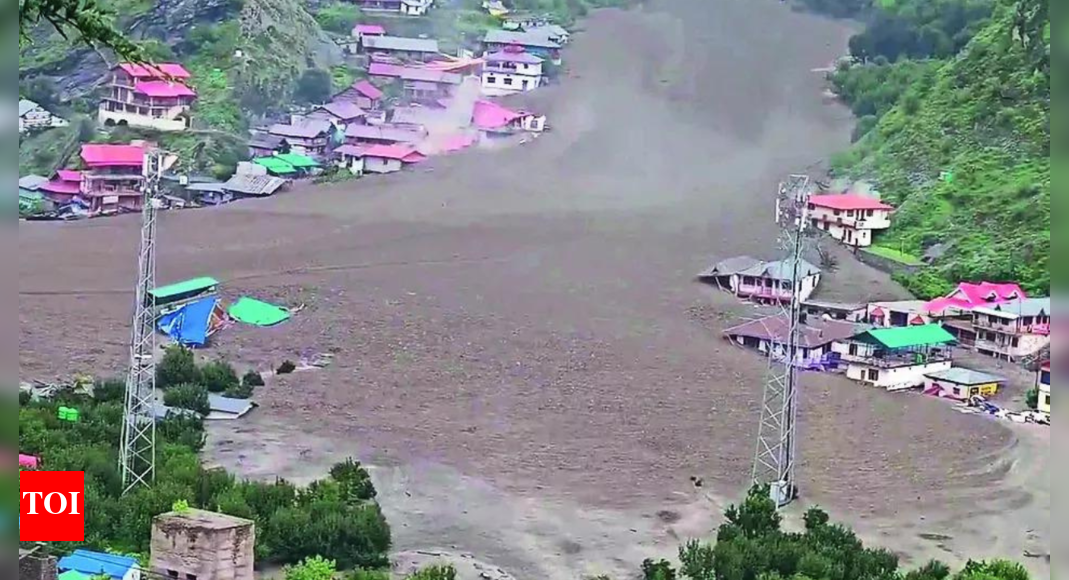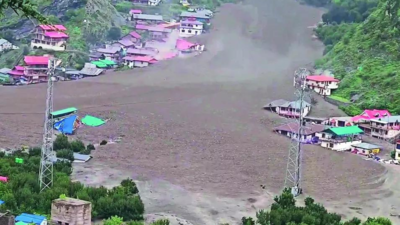DEHRADUN: It wasn’t simply the rain. A initial geological overview carried out after Tuesday’s devastating flash flood in Dharali village, suggests a much more complicated and violent set off – a large cave in of glacial sedimentary deposits, most likely brought about through a retrogressive slope failure prime up within the mountains.Preliminary estimates made through mavens, according to satellite tv for pc information and terrain research, level to an avalanche of just about 360 million cubic metres of particles. For viewpoint, a snappy, back-of-the-envelope calculation finds the determine is kind of similar to over 1.4 lakh Olympic-sized swimming swimming pools stuffed with dust, rocks and glacial particles concurrently hitting the village at prime pace. With such an have an effect on, it is not unexpected that Dharali didn’t have an opportunity. The avalanche used to be mobilised through a unexpected liberate of volatile morainic and glacio-fluvial material-thundering down the Kheer Gad flow into Dharali. The surge reached the village inside of seconds, knocking down over 20 constructions and claiming lives of no less than 4 other folks (as in line with professional figures).Imran Khan, geologist and head of the geology department at Bhutan’s Punatsangchhu-I hydel venture, who studied satellite tv for pc imagery of the world, stated “this wasn’t a normal cloudburst”. “The development most likely concerned a large detachment of unconsolidated glacial deposits, perched kind of 7 km upstream at an elevation of 6,700m. Heavy rainfall will have acted because the trigger-but the crisis used to be ready to occur.” The glacial deposit in query, spanning over 1.1 sqkm with an estimated vertical thickness of 300m, is positioned in a dangling trough – an inherently volatile geological function. The steep terrain, blended with slender, pre-incised channels within the Kheer Gad flow, allowed the particles to boost up at terrifying speeds, leaving nearly no time for citizens to flee. “The flow draining this space has a prime longitudinal gradient, restricted lateral confinement, and sharp incision paths-all of which give a contribution to speedy particles float mobilisation,” Khan wrote. He added floor runoff and percolation, following days of intense rain, will have loosened the sediment, triggering the cave in.Rajiv Saran Ahluwalia, geologist at Doon College, informed TOI that at velocities of 6-7m in line with 2nd, debris-laden flows are in a position to destroying any construction of their trail. “And if the speed doubles, the debris-carrying capability will increase through an element of 64,” he stated. Professionals consider glacial soften, intensified through increased temperatures within the days previous the crisis, will have compounded the instability. A senior glaciologist stated the appropriate motive will simplest be recognized as soon as real-time satellite tv for pc imagery – captured simply sooner than and after the development – is analysed or a flooring workforce conducts a survey upstream. “Apparently the flash flood originated throughout 3 slender valleys, with probably the most violent surge happening within the Kheer Gad. One thing odd took place up there. It wishes pressing investigation.”Geologists have for lengthy been calling for a ban on building alongside steep nala corridors and particles float paths, specifically in pilgrimage-centric areas like Gangotri. “We will be able to not have the funds for to forget about hidden upstream hazards – particularly in zones with rising human and pilgrimage footprints,” stated a geologist concerned within the overview.

